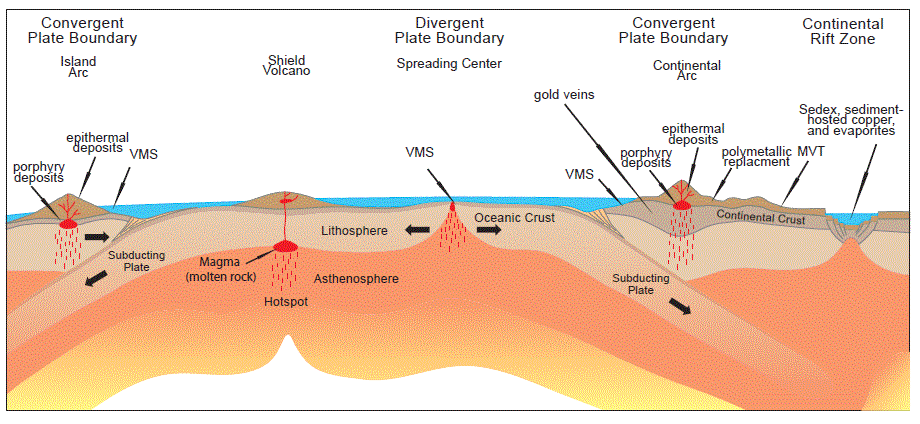Table of Contents
An ore is defined as a mineral or rock from which some valuable constituent, usually a metal, can be profitably extracted. Thus hematite and magnetite are ores of iron; galena is an ore of lead; zinc blende is an ore of zinc. With the ore-mineral is more or less material of no value, called gangue; and whether the ore as a whole can be profitably mined or not depends partly on the proportion of ore to gangue. The expression mineral deposits is conveniently used to cover both metal ores and other valuable minerals.
In the discussion of mineral deposits it is usual to include certain minerals of commercial value, such as talc, barite, apatite, feldspar, and fluorspar, which are not used as sources of metals.
Mineral Deposits
The valuable minerals sought by the prospector are probably always present in all rocks, but are generally so scattered and diffused as to be useless. Even in sea-water, gold can always be detected, and appreciable quantities have been found in granite, syenite, basalt, diabase, marble, and mud, quite apart from any workable ore deposits. Tin has been found quite generally in samples of granite to the extent of 0.05%.
Mineral deposits are exceptional concentrations. The natural concentration processes that have given us ore deposits have often used water as the agent in various ways, mechanical and chemical; but some ores, and perhaps many, have been separated directly from the rock magma while an intrusive mass has been cooling and solidifying. Magma is the liquid rock material below the solid crust of the earth. It comes to the surface as lava. It also pushes its way into the rocks as intrusive masses.
According to their origin, mineral deposits may be conveniently put in three classes:
- Magmatic segregations.
- Veins and other deposits in fissures, shear zones, joints, etc.
- Sedimentary deposits.
Magmatic Segregation
Magmatic Segregation, or separation and concentration of the ore from the cooling, crystallizing rock magma, has taken place where the magma has pushed its way upward and formed large masses (laccoliths, etc.) at sufficient depths to allow slow cooling. As the ore was heavier than the rest of the magma, it went to the bottom as it crystallized, or it may have separated in the liquid condition. The separation effect of the growth of crystals should also be taken into account. With very slow cooling, the crystals that first started, perhaps on the sides of the fissure, would attract their own substance from the liquid, and thus concentrate it in one place. The water and other solvents forming part of the molten rock doubtless in many cases tended to keep certain minerals in the liquid condition, and these, including some of value, would at last form a body of liquid in which the valuable materials were concentrated from a large body of rock. At a later stage, this liquid might be forced upwards into weak places in the rock and become a body of ore. There may have been every imaginable variation and continuation of this process in successive stages, from the simple separation of the ore and its solidification in or beside the parent rock, to the deposit of valuable minerals from the last concentrated liquid pushed into fissures in other rocks. Magmatic segregations, strictly considered, are only of the former kind, where the ore has been deposited in contact with the parent rock. Some of such deposits have no defined edges, but the ore slowly shades into the rock. The basic rocks, such as gabbro, norite, diabase, and peridotite are the commoner country rocks for magmatic segregations. Some ore bodies grade into the country rock, but others have well-defined walls. The ore bodies are apt to be irregular in shape, and not tabular, like veins. An exception to this is where the ore body is in the form of a dike or vein of solid ore, and without any of the parent rock; some titaniferous magnetite ore bodies are of this kind.
Pegmatite dikes
Pegmatite dikes are magmatic segregations that are thought to represent a late stage of the solidification of the parent body, when the magmatic water and other substances tending to keep the rock matter in the liquid condition promoted a very slow crystallization and the consequent growth of large crystals. In this way, the acid pegmatites sometimes supply large masses of pure feldspar, quartz, and mica.
The conditions were also favorable for the concentration of certain valuable minerals, for example, tinstone, molybdenite, monazite, scheelite, wolframite, topaz, rutile, uraninite, (commonly called pitchblende), tourmaline, emerald, ruby, sapphire, and the valuable lithium minerals, lepidolite, spodumene, and amblygonite.
